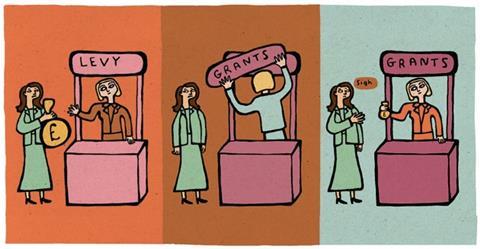Plasterers are sick of paying a training levy that really goes on jobs at the CITB. Who can blame them? We should be levying plasterboard makers at a fraction of the cost

The plasterers have well and truly fallen out with CITB-ConstructionSkills. The Federation of Plastering and Drywall Contractors says the “state-controlled levy system is hugely inefficient and a disincentive to training”. What’s up? Look. Plasterers are the heart of the real end of building. It’s a skills trade; it brings lads and lasses in, puts them with experienced plasterers and points them at walls and ceilings. Dads teach sons, sons teach grandsons.
For the plasterers to tell the CITB to go to blazes is ever so serious. What’s up is that the CITB is there to pay out for apprentices and invest in quality training, especially for kids. To do all that, the plasterers put money in; it’s called levy. Then they pop round the other side of the counter and take money out; it’s called grant. And it doesn’t work.
It doesn’t work because the grant doled out is a million miles short of the levy stumped up. It’s been a moan for years. And now, say the plasterers, things are even worse. In fact “the grants are now virtually worthless”. So the plastering boys did a bit of probing. They found that the interiors end of the building industry forked out £14.5m in levies in 2009 and got £6.2m back. Except that the £6.2m included CITB staff costs, so it’s not clear just what grant came back to the interiors folk.
The idea of industry training came about in 1964. Some 40 or so industrial training boards were set up. Widget makers and you-name-it makers became obliged by law to send a sub to their particular board. But the costs were enormous and eventually most were booted off the industrial pitch - except for two; one of which is construction. It stays by the skin of its teeth
The line taken by government is: “They exist because of wide support from employers and employer interest groups.” It adds: “The majority of employers supported the CITB levy proposals.” Convinced? Hmm? Spin?
The interiors end of the building industry forked out £14.5m in levies in 2009 and got back £6.2m
Cabinet Office guidelines issued in 2000 require government departments every five years “to conduct regular and challenging reviews” of the public bodies they are responsible for. It was called the quinquennial review programme. It was thorough. The last one I read put employer support for the CITB at just 58%. And it revealed: “Looking back over its history, the board has not had the fundamental and strategic impact on the industry’s recruitment and training problems that it might have hoped for … it has antagonised large sections of the industry.”
Those reviews gave the game away too easily. They no longer exist. The plasterers ought to now call for a thorough review by a government that says it intends “to set business free and reduce the number of unseen quangos that rule over our lives”.
The gripe is about being forced to pay a levy and not getting a fair return. So, either stop it altogether or get a fair return. How? Well now, let’s take plastering. Every plastering firm is an intermediary. A middleman. The firm buys plasterboard and fixes it. Every year each firm is asked to fill in a form to declare the number of fixers, and the levy is calculated from that number. Stop all that. Levy the plasterboard instead. The largest four plasterboard makers rely on thousands of plastering companies to buy the board and install it. The four are certainly part of the construction process, but pay no levy. The training of “their” plasterers is vital not only to the end customer but to the supplier. So put the levy on the plasterboard. Out go the millions of pounds spent by the CITB in the levy collection paperwork, and out go all those staff costs. Yes, yes, they really do count heads - thousands of forms, thousands of blokes, thousands of invoices and thousands of cheques to the CITB.
I asked the business and skills department to get the levy this way to fund apprenticeships. It says it would require the support of most of those likely to be liable to pay. Well then, that takes four letters. Business and skills also says it “can’t see a clear link between training people to be plasterers and making plaster”! And it says, which materials would we levy? Tough question. Answers on a postage stamp. Come on plasterers and plasterboard makers, and construction minister Mark Prisk, show us the way to apprentices.

























No comments yet